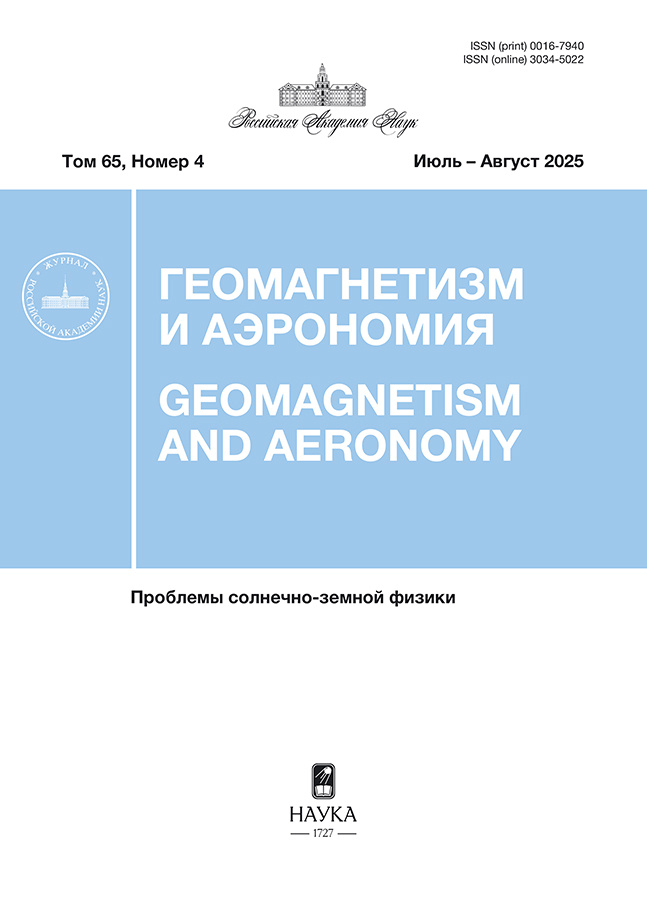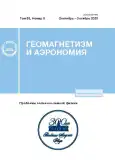Statistical Analysis of the Critical Frequency foF2 Dependence on Various Solar Activity Indices
- Authors: Danilov A.D.1, Berbeneva N.A.2
-
Affiliations:
- Institute of Applied Geophysics
- Faculty of Physics, Moscow State University
- Issue: Vol 63, No 5 (2023)
- Pages: 619-629
- Section: Articles
- URL: https://rjsvd.com/0016-7940/article/view/650987
- DOI: https://doi.org/10.31857/S0016794023600588
- EDN: https://elibrary.ru/XYMAUR
- ID: 650987
Cite item
Abstract
A description of the ionospheric F2-layer critical frequency foF2 dependence on solar activity by
various indices (proxies) has been analyzed. The results of the vertical ionospheric sounding at the Juliusruh
station during 2 winter months (January and February), 2 equinox months (March and October), and a summer
month (June) are considered. Five solar proxies: Ly-α, MgII, Rz, F30, and F10.7 have been analyzed.
The changes in foF2 are compared to the corresponding changes in 1957–1980. The determination coefficient
R2 according to the Fisher F-test is used as a measure of the quality of the description of the foF2 dependence
on SA by each of the proxies. It has been found that a well-pronounced diurnal variation in the R2 value
is observed in winter months: this is higher at the near-noon hours than at night. In other words, all indices
describe the foF2 behavior better in the daytime than at night. A well-pronounced diurnal variation in R2 is
also observed for four proxies in the equinoctial months, whereas that variation is pronounced much less for
Rz: a strong scatter of the R2 values is seen. A diurnal variation in the R2 is absent completely in June: jumps
from one hour to another are observed. This analysis allows us to conclude that the most reliable SA proxies
for description of the foF2 dependence on SA at all LT hours are MgII, F30, and Ly-α.
About the authors
A. D. Danilov
Institute of Applied Geophysics
Email: adanilov99@mail.ru
Moscow, Russia
N. A. Berbeneva
Faculty of Physics, Moscow State University
Author for correspondence.
Email: adanilov99@mail.ru
Moscow, Russia
References
- – Данилов А.Д. Долговременные тренды в верхней атмосфере и ионосфере (обзор) // Геомагнетизм и аэрономия. Т. 52. № 3. С. 291–312. 2012.
- – Данилов А.Д., Константинова А.В. Долговременные вариации параметров средней и верхней атмосферы и ионосферы (обзор) // Геомагнетизм и аэрономия. Т. 60. № 4. С. 411–435. 2020а.
- – Данилов А.Д., Константинова А.В. Тренды параметров слоя F2 и 24-й цикл солнечной активности // Геомагнетизм и аэрономия. Т. 60. № 5. С. 619–630. 2020б.
- – Данилов А.Д., Бербенева Н.А. Тренды критической частоты слоя F2 в последнее десятилетие // Геомагнетизм и аэрономия. Т. 63. № 2. С. 139–146. 2023.
- – Bilitza D. International Reference Ionosphere 1990. National Space Science Data Center, NSSDC 90–92, Greenbelt, Maryland. 1990.
- – Danilov A.D. Seasonal and diurnal variations in foF2 trends // J. Geophys. Res. – Space. V. 120. P. 3868–3882. 2015. https://doi.org/10.1002/ 2014JA020971
- – Danilov A.D., Konstantinova A.V. Trends in foF2 and the 24th solar activity cycle // Adv. Space Res. V. 65. P. 959–965. 2020. https://doi.org/10.1016/j.asr.2019.10.038
- – Danilov A.D., Konstantinova A.V. Trends in foF2 to 2022 and various solar activity indices // Adv. Space Res. V. 71. № 11. P. 4594–4603. 2023. https://doi.org/10.1016/j.asr.2023.01.028
- – De Haro Barbás B.F., Elias A.G. Effect of the inclusion of solar cycle 24 in the calculation of foF2 long-term trend for two Japanese ionospheric stations // Pure Appl. Geophys. V. 177. P. 1071–1078. 2020.
- – De Haro Barbás D.F., Elias A.G., Fagre M., Zossi B.F. Incidence of solar cycle 24 in nighttime foF2 long-term trends for two Japanese ionospheric stations // Stud. Geophys. Geod. V. 64. P. 407–418. 2020.https://doi.org/10.1007/s11200-021-0548 9
- – De Haro Barbás D.F., Elias A.G., Venchiarutti J.V., Fagre M.M., Zossi B.S., Jun G.T., Medina F.D. MgII as a solar proxy to filter F2-region ionospheric parameters // Pure Appl. Geophys. V. 178. P. 4605–4618. 2021.
- – De Haro Barbás B.F., Zossi B.F., Jun G.T., Bravo M., Ledesma M.M., Venchiarutti V., Gonzalez G., Medina F.D., Trinidad Duran T., Elias A.G. IRI performance considering Mg II as EUV solar proxy // Adv. Space Res. 2023.https://doi.org/10.1016/j.asr.2023.06.0007
- – Gulyaeva T.L., Arikan F., Sezen U., Poustovalova L.V. Eight proxy indices of solar activity for the International Reference Ionosphere and Plasmasphere model // J. Atmos. Sol.-Terr. Phys. V. 172. P. 122–128. 2018. https://doi.org/10.1016/j.jastp.2018.03.025
- – Laštovička J. Is the relation between ionospheric parameters and solar proxies stable? // Geophys. Res. Lett. V. 46. № 24. P. 14208–14213. 2019. https://doi.org/10.1029/2019GL085033
- – Laštovička J. What is the optimum solar proxy for long-term ionospheric investigations? // Adv. Space Res. V. 67. № 1. P. 2–8. 2021a. https://doi.org/10.1016/j.asr.2020.07.025
- – Laštovička J. The best solar activity proxy for long-term ionospheric investigations // Adv. Space Res. V. 68. P. 2354–2360. 2021b. https://doi.org/10.1016/j.asr.2021.06.032
- – Laštovička J. Long-term changes in ionospheric climate in terms of foF2 // Atmosphere. 13(1). 110. 2022. https://doi.org/10.3390/ atmos13010110
- – Laštovička J. Progress in investigating long-term trends in the mesosphere, thermosphere and ionosphere. 2023. https://doi.org/10.5194/egusphere-2023-302
- – Laštovička J., Burešová D. Relationships between foF2 and various solar activity proxies // Space Weather. V. 21. e2022SW003359. 2023. https://doi.org/10.1029/2022SW003359
- – Lean J., Emmert J.T., Picone J.M., Meier P.R. Global and regional trends in ionospheric electron content // J. Geophys. Res. – Space. V. 116. A00H04. 2011. https://doi.org/10.1029/2010JA016378
- – Perna L., Pezzopane M. foF2 vs solar indices for the Rome station: looking for the best general relation which is able to describe the anomalous minimum between cycles 23 and 24 // J. Atmos. Sol.-Terr. Phys. V. 148. P. 13–21. 2016. https://doi.org/10.1016/j.jastp.2016.08.003
- – Sivakandan M., Mielich J., Renkwitz T., Chau J.L., Jaen J., Laštovička J. Long-term variations and trends in the E, F and sporadic E (Es) layer over Juliusruh, Europe // J. Geophys. Res. – Space. V.128. e2022JA031097. 2022. https://doi.org/10.1029/2022JA031097
- – Venchiarutti J.V., Farge M., Zossi B.S., Tan Juan Rios G., Medina F.D. Mg II as a solar proxy to filter F2-region ionospheric parameters // Pure Appl. Geophys. V. 178. P. 4605– 4618. 2021. https://doi.org/10.1007/s00024-021-02884
- – Zhang S.R., Cnossen I., Laštovička J., Elias A.G., Yue X., Jacobi C., Yue J., Wang W., Qian L., Goncharenko L. Long-term geospace climate monitoring // Frontiers in Astronomy and Space Science. V. 10. 2023. https://doi.org/10.3389/fspas.2023.1139230
Supplementary files






















